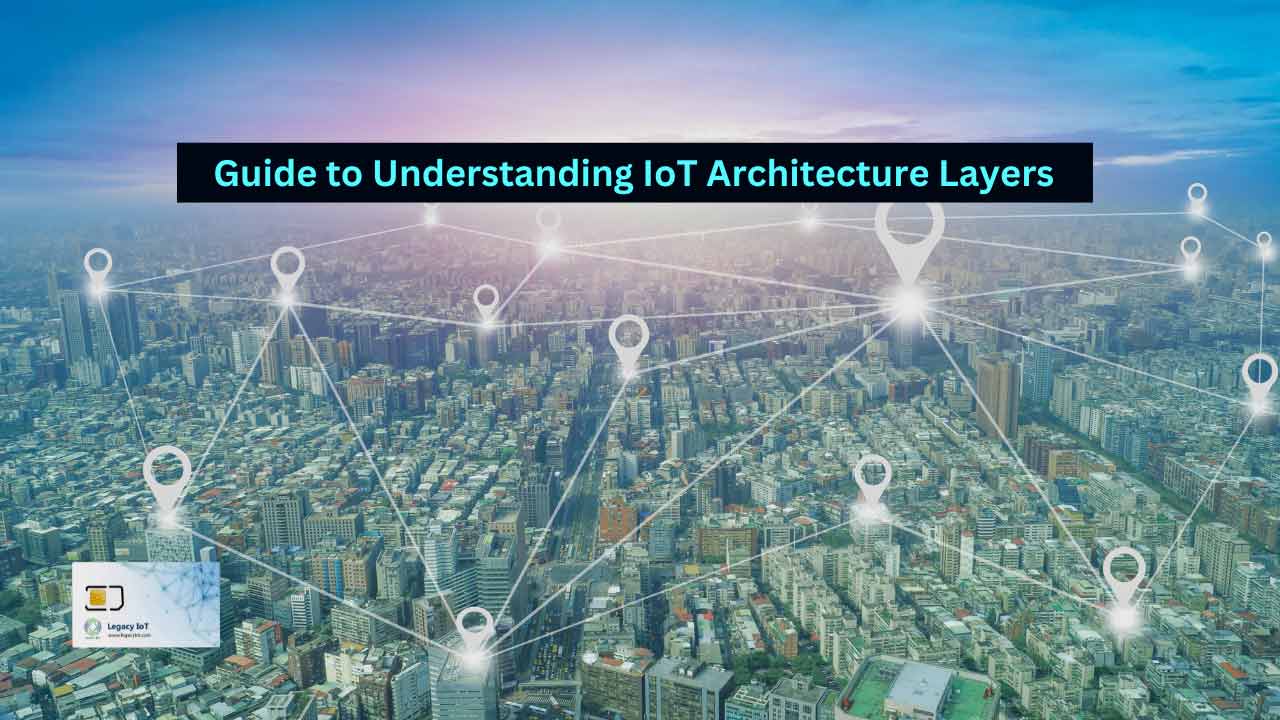The Internet of Things (IoT) is a transformative ecosystem that connects various devices to the internet, allowing them to collect, share, and act on data.

Effective management of this system requires a structured approach, which is achieved by organizing IoT architecture into distinct layers. Let’s dive into these layers to see how they function and contribute to the overall IoT system.
Device Layer (Sensing Layer)
Components:
- Sensors
- Actuators
- Embedded devices
Function:
“Device Layer” or “Sensing Layer” refers to the lowest tier of the Internet of Things architecture. It encompasses all the physical devices that interact with the environment to collect data and perform actions.
Sensors in this layer measure various parameters like temperature, humidity, light intensity, and motion, converting them into electronic signals for further processing and analysis. A smart thermostat’s temperature sensor, for example, gauges the surrounding air temperature.
Actuators are frequently used in embedded systems; they cooperate with sensors to carry out actions that are directed by the system. As an illustration, consider smart light bulbs, which interact with the real environment directly by turning on or off in response to signals from controlling equipment through m2m sim card.
Connectivity Layer
Components:
- Gateways
- Communication protocols (e.g., Wi-Fi, Bluetooth, Zigbee)
Function:
The Connectivity Layer serves as the bridge between the physical devices in the Device Layer and the central processing units or cloud services. Across the network, this layer guarantees smooth communication and data transfer.
Gateways are pivotal in this layer which are also known as IoT Gateway. They aggregate data from multiple sensors and devices, translating it into a format suitable for transmission over various networks. For example, a home automation gateway collects data from smart thermostats, security cameras, and lighting systems, then transmits this information to the cloud for processing.
Communication protocols like Wi-Fi, Bluetooth, Zigbee, and others facilitate this data exchange. Each protocol has its strengths, with Wi-Fi being ideal for high-bandwidth applications, Bluetooth for short-range, low-power communication, and Zigbee for low-power, low-data rate applications in mesh networks. The IoT application’s particular requirements will determine which protocol is used.
Edge Computing Layer
Components:
- Edge devices
- Edge servers
Function:
The Edge Computing Layer processes data at the network’s edge, closer to where it is generated. This close proximity lowers latency, conserves bandwidth, and improves the responsiveness of Internet of Things applications.
Initial data processing, including filtering, aggregation, and early analysis, is carried out by Edge devices and Edge servers.
By handling these tasks locally, edge computing minimizes the amount of raw data that needs to be sent to the cloud, thus optimizing network usage and ensuring quicker decision-making.
For instance, in a smart surveillance system, edge computing allows video data to be processed locally on the camera or an edge server. This can include identifying movement or recognizing faces, and only the relevant information or alerts are sent to the cloud, reducing the need for continuous high-bandwidth transmission.
Data Processing Layer (Cloud Layer)
Components:
- Cloud servers
- Data storage
- Analytics platforms
Function:
The Data Processing Layer, often referred to as the Cloud Layer, is the central hub where the heavy lifting of data storage, processing, and analysis takes place. This layer provides the computational power and scalability required to handle the vast amounts of data generated by IoT devices.
Massive dataset management and storing are made possible by Cloud servers and Data storage systems. They provide scalable and flexible resources that can grow with the increasing data volumes typical of IoT deployments.
Analytics platforms within this layer enable sophisticated data processing tasks. For example, in a smart city application, data from various sensors (traffic, weather, pollution) is analyzed in the cloud to optimize urban planning and enhance the quality of life for residents.
Application Layer
Components:
- Software applications
- User interfaces
- Dashboards
Function:
The Internet of Things is accessed by end users through the application layer. It offers the tools and interfaces required for managing, observing, and displaying data from Internet of Things devices.
Software applications and user interfaces can range from mobile apps to web-based dashboards, providing users with real-time visibility and control over their IoT devices through IoT management portal. For instance, a smart home app allows users to monitor and control their lighting, heating, and security systems from anywhere in the world.
Dashboards provide consumers with visual representations of data, which facilitates understanding trends and helps them make wise decisions. Alerts and notifications are also managed in this layer, ensuring users are promptly informed of any critical events or anomalies.
Security Layer
Components:
- Encryption
- Authentication mechanisms
- Security protocols
Function:
Security is a critical aspect that permeates all layers of IoT architecture, ensuring data integrity, confidentiality, and availability. The Security Layer implements measures to protect the IoT ecosystem from potential threats.
Encryption is employed to safeguard data at rest and in transit, ensuring that sensitive information cannot be easily intercepted or tampered with. Systems that employ Authentication mechanisms confirm users’ and devices’ identities, limiting unwanted access.
Security protocols are implemented across the entire architecture to establish secure communication channels and enforce policies that protect against cyber threats. Robust authentication and authorization mechanisms ensure that only authorized users and devices can access specific data and functionalities, thereby maintaining the integrity and reliability of the IoT system.
Conclusion
To utilize IoT to its fullest extent, one must comprehend its entire architecture. Each layer, from the Device Layer that captures real-world data to the Application Layer where users interact with insights, plays a vital role in creating a seamless and efficient IoT ecosystem.
By integrating these layers – Device, Connectivity, Edge Computing, Data Processing, Application, and Security, organizations can build robust IoT solutions that drive innovation and improve operational efficiency.
As IoT technology continues to evolve, staying informed about these architectural layers will be key to harnessing its transformative power and achieving a connected, smarter future. For more insights and updates on IoT architecture, stay tuned to our Legacy IoT blogs.





